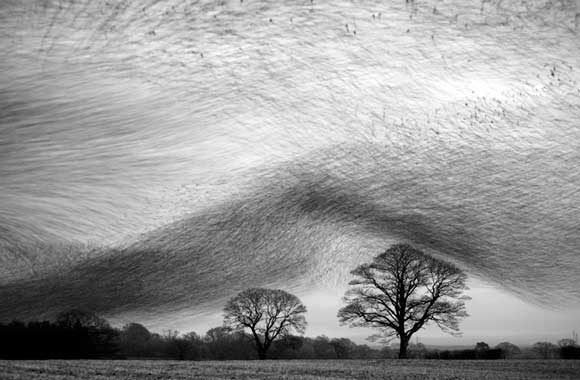The Wildlife Photographer of the Year competition is always one of the highlights of the photographic year. Here’s a selection the 2009 winners…
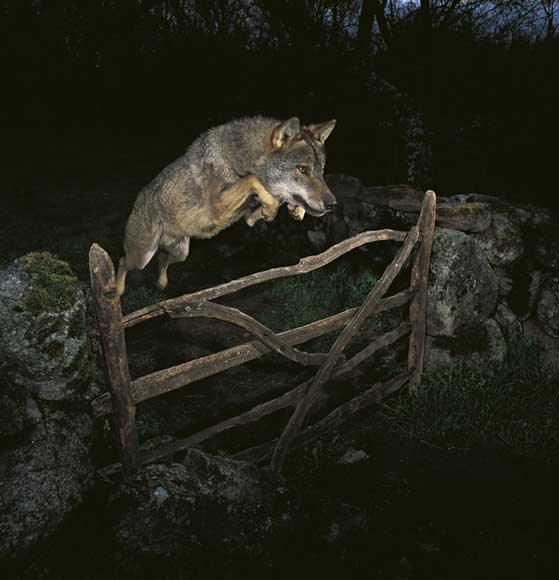
Now in its 45th year, the annual Wildlife Photographer of the Year competition is very much the Oscars equivalent within the world of wildlife photography and, as such, has always attracted huge numbers of entries from amateur and professional photographers keen to showcase their work.
Co-owned by the Natural History Museum and BBC Wildlife magazine, this year the competition was sponsored by waste management organisation Veolia Environment and received over 43,000 entries from 96 countries. So how did the judges pick their winners? According to Mark Carwardine, chair of the judging panel, there is no such thing as a ‘magic formula’ for winning, although there is one special quality all the judges looked for: ‘While there are no hard and fast rules to explain why one photograph wins and another doesn’t, all of the winning shots have one thing in common – originality,’ he explained.
‘The competition plays an increasingly crucial role in raising the profile of wildlife photography and generating awareness of conservation. Nothing speaks louder than an evocative photograph that stirs the imagination, tugs at the heartstrings and engages the mind,’ he added.
José Luis Rodríguez, Spain
Animal Portraits – Winner with ‘The Storybook Wolf’
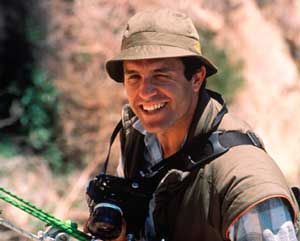 When José Luis realised he had got the shot of his dreams – one that he had even sketched on paper – he couldn’t quite believe it. From the start, his fear had been that the wolves would be too wary.
When José Luis realised he had got the shot of his dreams – one that he had even sketched on paper – he couldn’t quite believe it. From the start, his fear had been that the wolves would be too wary.
Iberian wolves have always been persecuted by people who see them as a threat to game and livestock (which they hunt when natural food is scarce) but also because of ignorance and superstition about the supposed danger they pose. Even though they have always lived close to humans, there are no verified incidences of them attacking people.
In Spain, the population of Iberian wolves – a subspecies of the grey wolf – is thought to number 1,000-2,000 in the north, with a few tiny, isolated populations in the south. José Luis risked a slow shutter-speed to reveal the moonlit sky and conjure up the atmosphere of the place. He switched from using his Nikon D2X to a Hasselblad so he could get the exact framing that he had in mind. What José Luis hopes is that his picture, ‘showing the wolf’s great agility and strength’, will become an image that can be used to show just how beautiful the Iberian wolf is and how the Spanish can be proud to have such an emblematic animal.
Shot Info (top) – Hasselblad 503CW with a 6×6 Fujichrome backing, Planar 80mm lens; 1/30 sec at f/11, ISO 50. Shutter release triggered via a purpose-made Ficap infrared camera trap.
Award winning image disqualified – Read Story
Tom Schandy, Norway
Gerald Durrell Award for Endangered Wildlife – Winner with ‘The Look of a Jaguar’
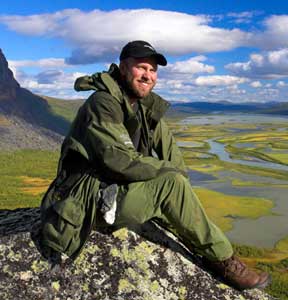 The subjects featured here are species officially listed as critically endangered, vulnerable or at risk, and the purpose of the award is to highlight, through photographic excellence, the plight of wildlife under threat.
The subjects featured here are species officially listed as critically endangered, vulnerable or at risk, and the purpose of the award is to highlight, through photographic excellence, the plight of wildlife under threat.
In a small, protected area of swamp-forest in the western area of the Pantanal wetland, in Mato Grosso, Brazil, jaguars still roam free from human harassment. They’re notoriously difficult to see, and pawprints are as lucky as most people get. Along the riverbanks, though, it’s possible to spot them. When Tom took a boat down the Rio Paraguay, he saw four jaguars in three days. This male had picked a slightly concealed spot where he could watch for prey such as capybara. Tom observed him for an hour. ‘He was totally calm, even though he was aware of us.’ At sunset, the jaguar rose, yawned and scent-marked. Then he faded back into the dense forest.
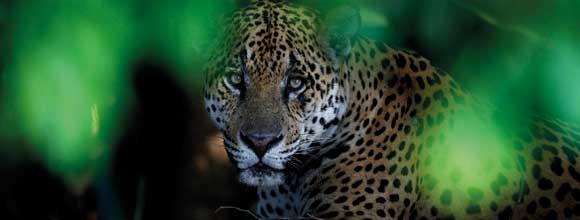
Canon EOS 1D Mark III, 500mm f/4 lens; 1/250 sec at f/4, ISO 400; beanbag
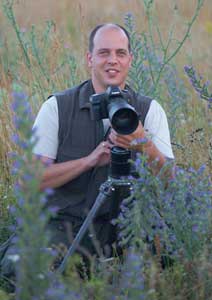 András Mészáros, Hungary
András Mészáros, Hungary
Animal Behaviour: All Other Animals – Winner with ‘Raindrop Refresher’
‘The beauty of macro-photography,’ says András, ‘is the worlds it reveals – all the activity going on in miniature that you otherwise would never see.’
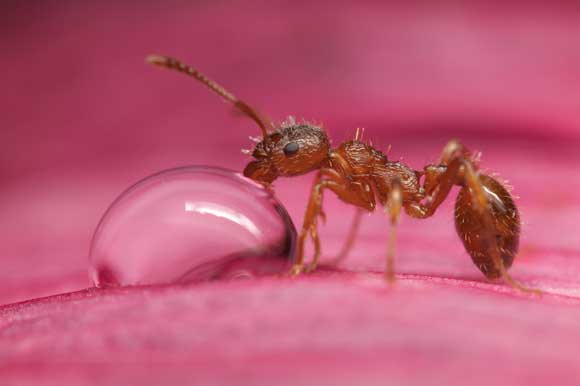
Canon EOS 5D, Canon EF 50mm f1.8 reversed, 2x extension tubes, Canon 1.4x teleconverter; 1/200sec at f/9, ISO 200.
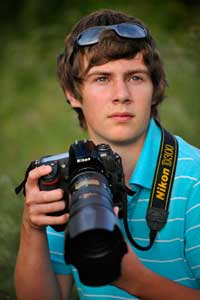 Fergus Gill, UK
Fergus Gill, UK
15-17 Years Old – Winner with ‘Clash of the Yellowhammers’
‘I woke early, got into my hide and waited,’ explains Fergus. ‘After a few hours, the garden was full of birds. At one point I counted 32 yellowhammers feeding on the ground. After another couple of hours, more snow fell and the yellowhammers began jumping up and feeding on the sheaf. Every so often I would see a fight between two males over ownership of the oats, but the spats were incredibly fast.’
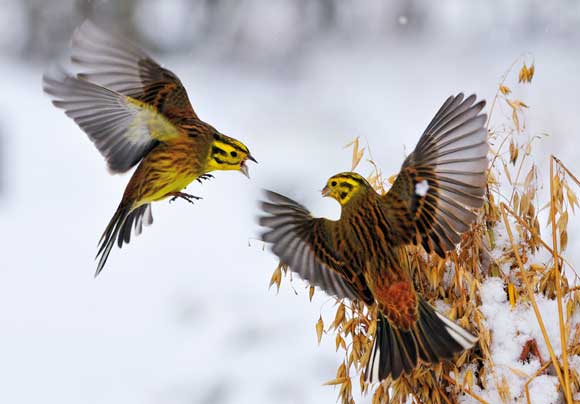
Nikon D300, Nikon 200-400mm f/4 lens at 220mm; 1/1000sec at f/5.6, ISO 500.
Danny Green, UK
Nature in Black and White – Winner with ‘Starling Wave’
Starling populations in the UK swell in December and January as birds from the Continent head for milder wintering areas. Huge flocks roost in many spots throughout the country, and as Danny has been working on a long-term project to photograph these impressive roosts, he has visited most of them. ‘This gathering,’ says Danny, ‘was by far the most impressive I have ever seen.’ The location was Gretna Green, Scotland. The stage was set: a perfect evening, hundreds upon thousands of starlings. And then the main character appeared, off stage-left – a peregrine falcon, which sent ripples of pulsating panic throughout the entire flock. ‘I used a slow shutter-speed,’ says Danny, ‘so I could accentuate this lovely sweeping movement as the birds exploded over farmland and trees to escape the hunting peregrine.’
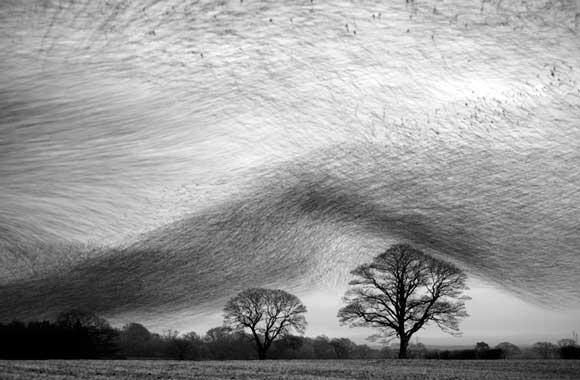
Canon EOS-1Ds Mark II + Canon 70-200mm lens; 1/3 sec at f2.8; ISO 400.

